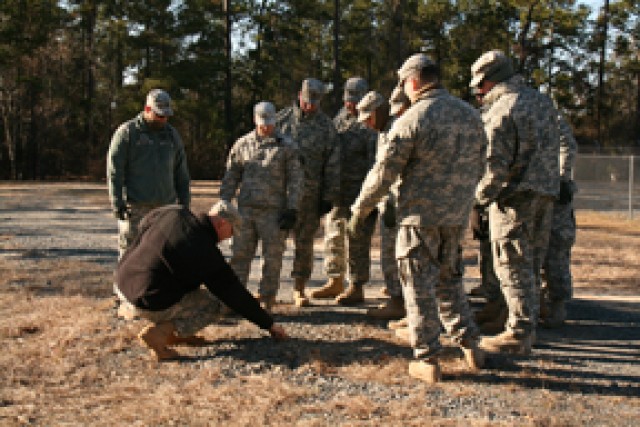FORT POLK, La. -- The copper tripwire running across the dirt road was barely noticeable. Even at a walking pace, a team of combat advisors with engineer and infantry backgrounds unknowingly detonated the device connected to the wire as they walked past a tree.
Their focus had been on a suspiciously placed log about 20 meters up the road, rather than on the threat right in front of them. Had this been a real mission, the entire team would have ended up casualties to the greatest threat to U.S. and coalition forces in Iraq and Afghanistan -- the improvised explosive device.
Fortunately, the misstep was only part of a training exercise on the dismounted IED lane conducted Jan. 9 by Company A, 4th Battalion, 353rd Infantry Regiment, 162nd Infantry Brigade, to familiarize combat advisor teams with the threats they'll face on their impending deployments. The dismounted IED lane on North Fort Polk completes a full day of IED-defeat instruction as part of the 60-day training cycle for combat advisors conducted by the 162nd Infantry Brigade. Most of the teams will serve as advisors for local national forces like the Afghan National Army or Iraqi police in combat zones.
"You think about coming through this lane at 17 mph (while driving in a convoy), instead of walking it like we did, you would blow past a lot of this," said 1st Sgt. Bill Nelson, Operational Mentor Liaison Team 1.4 of the Ohio National Guard. "The training gave us a lot of good areas to focus on, like the types of IED emplacements. It gives us a whole new depth of the type of training we can continue to do after we deploy. It doesn't end here."
While walking the dismounted IED lane, hasty and deliberate emplacement techniques are demonstrated for the combat advisors, who may "detonate" IEDs by setting off tripwires, stepping on concealed pressure plates, or being overly curious and picking up war trophies left on the ground.
"The majority of the combat advisors that we train have never deployed or been involved in an IED attack, so our mission is to make the dismounted IED lane as realistic as possible," said Sgt. 1st Class Isaias Cruz, a small group advisor for Company A. "During the lane, we hit the combat advisors with different scenarios that we have compiled through both experience and the latest intelligence."
Scenarios also exposed teams to radio-controlled IEDs, command-wire IEDs, explosively-formed projectiles, prior blast sites, complex attacks and "daisy chain" explosives that are linked.
The dismounted lane reinforces how to identify different threat and danger areas while on patrol, enemy IED emplacement techniques, IED indicators (warning signs) and different types of IEDs used in current theaters of operation. In particular, the dismounted lane gives combat advisors a close-up view of the most typical locations that IEDs are placed, including curves, choke points, soft sand, up- and down-hill slopes and culverts.
"The dismounted training serves as a good building block leading up to the mounted combat patrol/live-fire exercise that is conducted later on. The training offers a direct understanding of the five Cs -- check, confirm, clear, cordon and control -- and the importance of scanning while on a patrol," said Lt. Col. Curtis B. Hudson Jr., commander, 4th Bn, 353rd Reg.
Consequently, combat advisors are taught to maintain 360-degree security and situational awareness. The dismounted lane allows the combat advisors to identify how strong an IED indicator might be, whether it's an old pothole now covered with dirt or sand (a "strong" indicator), possibly with a wire extending from it (making it an "absolute" indicator), or just a tree branch or piece of trash in the road (a "weak" indicator).
"Instead of suspecting everything they see, they learn to quickly eliminate what is not dangerous," said Sgt. 1st Class Gerald Pickett, Co A. "Combat advisors become more observant and train the naked eye to identify IED indicators.
The advantage they gain allows the combat advisors to mitigate risks during the planning phase back at the (base)."
A second team from OMLT 1.4 picked up on the importance of scanning as they walked around a blind turn. Having learned that corners are common locations for the enemy to emplace an IED, the team's level of alertness raised as they rounded the corner. The group picked up on a wire poking up out of the dirt in a washed out part of the road.
"You're so trained to look straight ahead of you," said 1st Lt. Nick Gibson, whose team will head to Afghanistan after further training in Hungary. "If I hadn't seen the indicators they trained us on, I wouldn't have looked twice. Every single thing we took away from this training will be applicable down the road."


Social Sharing